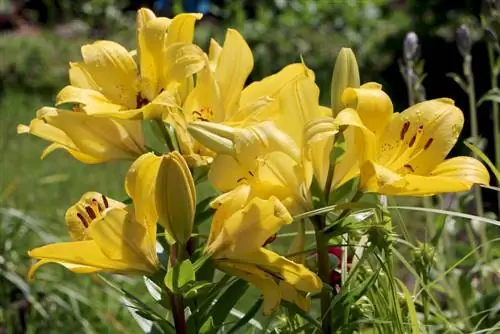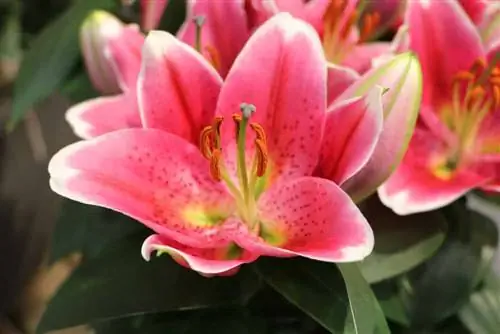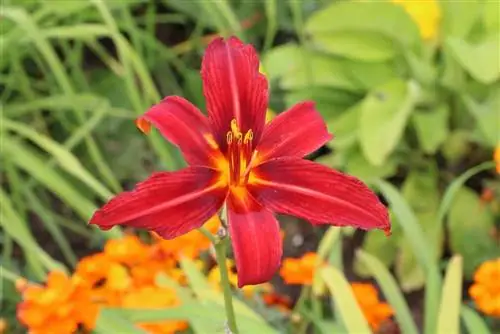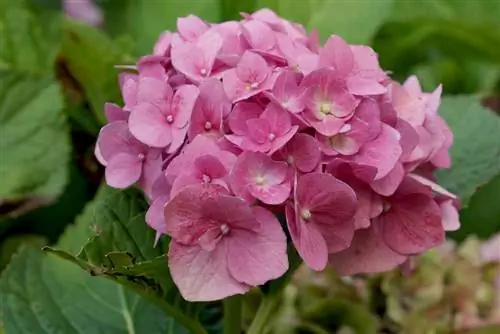- Author admin [email protected].
- Public 2023-12-17 03:39.
- Last modified 2025-01-24 12:45.
Lilies grow in the wild, bot. Lilium, in the temperate climates of the northern hemisphere. The genus Lilium includes around 125 species, many of which are hardy. However, the statement “hardy” refers to planted lilies, because the German winter causes problems for the plants when grown in containers. That's why they can only survive the cold season with the help of the hobby gardener.
Location
- Lilies in pots must be kept cool over the winter. The ideal winter quarters have the following characteristics:
- cool (5 degrees Celsius)
- dark
- wind and rain protected
- dry
A dry, unheated cellar or garage, for example, meets these requirements. The unheated staircase is out of the question for lilies because it is too bright and too warm.
Wintering inside
When lilies overwinter, not the entire plant overwinters, but only its underground part, the bulb.
That's why the plants need to be prepared. This includes:
- Stop fertilizer applications from the end of August
- cut back above-ground plant parts (about a hand's width above the substrate)
As with your garden colleagues, you should only cut back the above-ground parts of the plant when they have completely wilted. If the above-ground parts of the plant are brown and withered, this is a sign that the onion has drawn all the nutrients from the green parts of the plant. Because these nutrients serve as a reserve for the cold season.
Tip:
To avoid transmitting pathogens with the cutting tool, you should only use clean or disinfected tools. Because fungal infections are one of the biggest dangers when overwintering plants.
When it comes to the question of how the onion overwinteres, you have two options:
Leave onions in the pot
With Lilium, it is not necessary to dig up the bulbs and store them. Simply place the planter and the bulb in an appropriate location. It is important that the earth is very dry.
Dig up onions
If you don't want the bulbs to overwinter in the planter, you can also dig them up. Follow the instructions below:
- Dig up onions
- Carefully remove above-ground plant parts (stems and leaves)
- Remove adhering soil under running water
- Let the onions dry for a few days in a cool and airy place (avoid temperature shock)
- Temperature: 15 to 20 degrees Celsius
- Location: Garage or Shed

If the onions are well dried, they can be stored. Dry containers are suitable for this, such as
- a wooden box
- a box with air holes
Both containers are filled with wood wool in advance. Place the onions so that they do not touch each other to avoid mold growth. Then cover the onions with wood wool; they should be embedded really nicely. Then they go to winter quarters.
Care
Since the bulbs are in a dormant phase during the winter, they do not require any care. However, you should regularly check unearthed onions for mold growth. When overwintering in the pot, you should check whether mold has formed on the remaining parts of the above-ground plant parts. If you notice a fungal infection, you should remove the relevant bulbs or plants immediately.
While fertilizer is not applied throughout the winter, opinions differ as to whether the onions in the pot should be watered. Although there is agreement that the substrate must be kept very dry during the cold season, some people recommend watering the plants about once a month. On the other hand, it is recommended not to water the bulbs at all.
Start and end of the outdoor season
The outdoor season for potted lilies ends with the first frost at the latest. This is also the time to cut off the above-ground parts of the plant. The outdoor season begins when there is no longer any threat of (night) frost. This weather occurs in most regions of Germany from mid-May after the Ice Saints. Despite this late start to the outdoor season, the plants do not have to stay in their winter quarters until then, but can leave them beforehand. From February onwards, place the planter in a bright window seat as this will stimulate new growth. This also allows the plants to slowly get used to the light.
Wintering outdoors
Since temperatures in this country often fall below five degrees Celsius in winter, overwintering outdoors is only an option for potted lilies in exceptional cases, namely in very mild regions. But even there, the plants need winter protection after they have been prepared, as with overwintering indoors. The cold quickly penetrates through the thin walls of the pot into the substrate and causes it to freeze. Therefore, the onions must be protected from all sides:
- Cover the side walls of the pot with a cold protection fleece or a similar material (wrap it)
- from below: place the planter on a wooden or polystyrene plate
- from above: cover substrate with brushwood or leaves against cold, wet and snow, cover well
Another protective measure relates to the location. This should be protected from the wind. Protect the plants from rain and snow by placing them under an eaves or roof. Since the onions are supposed to overwinter in a dark place, they must not be left in the blazing sun, as the warmth of the sun is a sign for them to sprout.






